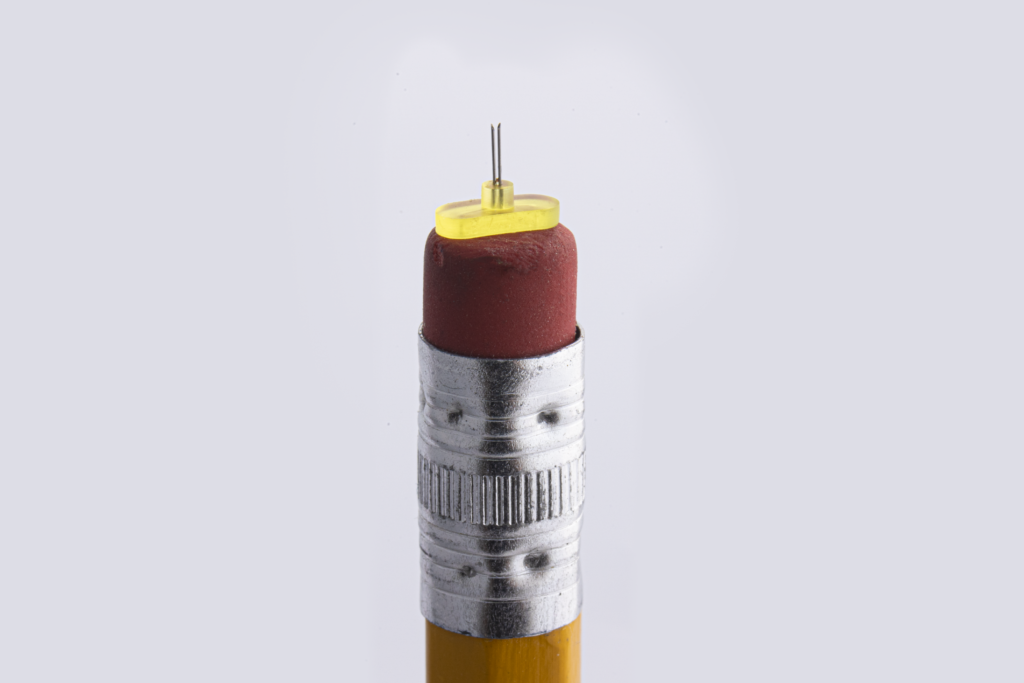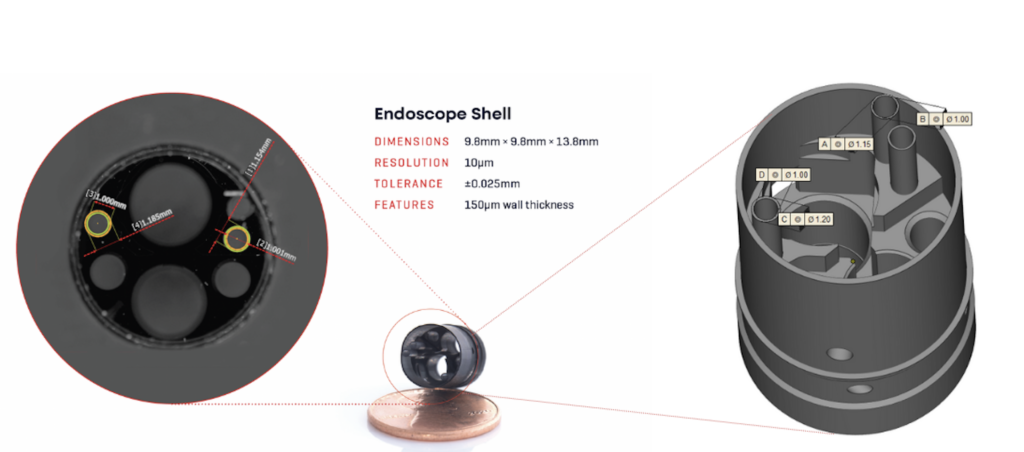Medical Product Outsourcing published an article about medtech and micromolding that made me think about the future of micro 3DP for medical devices. “Smarter, faster, cheaper. Those three words have become the unofficial motto of medtech development in recent decades,” wrote Michael Barbella in an article from October 2019. Barbella, MPO’s Managing Editor, also interviewed industry leaders as part of a roundtable discussion about the micromolding industry.
In recent years, a growing number of companies have started offering micromolding services. Yet few of these companies are fully focused in this area. Some describe their services as an additional molding capability. Others are contract manufacturers who specialize in microfabrication and have added micromolding to become fully integrated. Regardless, micro molding services are growing because of innovation-driven demand. In short, more medical device companies want “smaller, faster, cheaper”.
For some perspective, consider other trends in both the molding and microfabrication industries. By eliminating runners, molders reduce the waste of expensive molding materials. Five-axis micro CNC machining and micro sinker EDM support micron-level details with accuracy. There have also been automation-related advancements in the handling, packaging, and inspection of micro components. All of these developments are designed to push the limits and reach the goal of “smaller, faster, cheaper”.

Why is Micro 3D Printing Missing?
Yet I rarely hear the medical device industry demand “smaller, faster, cheaper” for prototyping and development. Is it because there isn’t a viable solution? Traditional manufacturing methods such as micro injection molding are expensive and time-consuming. Current 3D printing technologies can reduce costs and timelines, but they can’t produce microscale parts with the resolution, precision, and accuracy that’s required. Meanwhile, the demand for medical device miniaturization grows.
Think about the growth in tiny parts like microneedles, septums, sheaths, sensors, microelectronics, and assembled devices. It’s the result of growing requirements for less invasive surgical procedures, point-of-care applications, and advancements in targeted drug delivery, in-vitro diagnostics, implants, and wearable technologies. All of this requires “smaller, faster, cheaper” – and a search for a standard and a technology that can meet this demand.

Micro Components: Working Standard and Micro 3DP Solutions
For many years, I’ve searched for an industry standard that defines the difference between a micro component and a high-precision mini component. I’ve seen and heard a number of different definitions such as shot size, part size, feature size, and tolerances – just to name a few. For the sake of argument, let’s say that a micro component has the following specifications.
- From microscopic in size to large enough to fit inside a 1” square or diameter
- Wall thicknesses of .004” (.102 mm)
- Features like edges and corners within R.001” (.025 mm)
- Holes as small as R.002” (0.51 mm)
- Tip radii of R.0002” (.005 mm)
- Aspect ratios as high as 250:1
- Tolerances of ±0.0005” (0.0127 mm).
With specs like these, you can see why micro molders are highly specialized. You can also see why many in the industry think that there’s no easy way to prototype microscale components. Until now.
Boston Micro Fabrication (BMF) has developed a patented process called Projection Micro Stereolithography (PµSL) that 3D prints true microstructures with an ultra-high printing resolution (2µm~50µm) and printing tolerance (±10µm ~ ±25µm). BMF’s 3D printers use projection micro-stereolithography (PμSL), a form of stereolithography (SLA) that incorporates a DLP® light engine, precision optics, motion control, and advanced software.
SLA produces parts in layers using a photochemical process. A photosensitive liquid resin is exposed to light so that polymeric cross-linking and solidification occurs. With PμSL technology, a flash of ultraviolet (UV) light causes the rapid photopolymerization of an entire layer of resin. PμSL technology supports continuous exposure for faster processing.

The BMF microArch S240 System
Table 1 below contains design features and values for the BMF microArch S240 system. As you can see, this PµSL platform can meet the requirements of micro molding. The Recommended column contains values you can achieve with standard printer settings. The Advanced column contains values that may be achievable with the right design and under optimal conditions. BMF can review design and machine considerations with you and provides advanced users with advice about targeted settings.
| Design Feature | Recommended | Advanced |
| Maximum part size | 100 x 100 x 75 mm | |
| Minimum part size | 1 mm3 | 0.5 mm3 |
| Minimum feature size | 0.05 mm | 0.01 mm |
| Minimum hole diameter (vertical) | 0.05 mm | 0.04 mm |
| Minimum hole diameter (horizontal) | 0.15 mm | 0.1 mm |
| Maximum unsupported hole diameter | 2.0 mm | 3.0 mm |
| Minimum wall thickness (supported) | 0.05 mm | 0.02 mm |
| Minimum wall thickness (unsupported) | 0.1 mm | 0.05 mm |
| Minimum unsupported overhang angle | 30° | 20° |
| Maximum bridged overhang length | 1.5 mm | 5 mm/10 mm (rigid material) |
| Maximum non-bridged overhand length | 0.3 mm | 0.5 mm |
| Aspect ratio for channels | 100:1 | 500:1 for > ø 0.1 mm |
| Aspect ratio for pins & pillars | 40:1 | 100:1 for > ø 0.1 mm |
| Minimum feature clearance | 0.1 mm | 0.05 mm |
| Recommended channel shape > ø 100 µm | rectangular or circular | |
| Recommended channel shape < ø 100 µm | circular | |
| Part-to-part spacing | 0.1 mm | 0.05 mm |
| Layer height | 0.01 – 0.05 mm | |
| Support structure shape | cone | |
| Support structure cone top diameter | 0.08 – 0.2 mm | |
| Support structure cone base diameter | 0.1 mm – 1mm |
Table 1: microArch S240 Design Features and Values
PµSL Powers Micro 3DP for Medical Devices
PµSL technology from BMF provides a demonstrated solution for the prototyping and development of medical devices and components at the microscale. Today, BMF is also seeing a growing number of applications where PµSL technology can be used to cost-effectively manufacture end-use components. Even more opportunities will arise as the material properties and production speeds improve.
Would you like to learn more about Micro 3D Printing? Contact BMF to discuss your application.
About Boston Micro Fabrication
Boston Micro Fabrication (BMF) provides advanced manufacturing solutions for ultra-high precision applications. As a leading manufacturer of micro-precision 3D printers for use cases that require the unique combination of excellence in three key areas: resolution, accuracy, and precision, BMF acts as a manufacturing solutions provider and partner.
BMF manufactures high precision micro 3D printers. The company’s microArch system uses a 3D printing approach called PμSL (Projection Micro Stereolithography) that leverages light, customizable optics, a high quality movement platform and controlled processing technology to produce the industry’s most accurate and precise high-resolution 3D prints for product development, research and industrial short run production. The technology represents a true industry breakthrough by empowering product manufacturers to capitalize on the benefits of 3D printing without sacrificing quality or scale. Today, BMF is the only industrial 3D printing company to match the quality of high-resolution injection molding and CNC processing. To learn more, please visit bmf3d.com or follow us on LinkedIn.
